Culture of Arunachal Pradesh
Arunachal Pradesh is well known for its ancient culture. Known as the 'Land of Rising Sun', Arunachal Pradesh finds mention in prominent scriptures of India, such as the Kalika Purana and Mahabharata. Sage Parashurama washed away his sins in Arunachal which was then known as Prabhu Mountains. Sage Vyasa meditated in the forests of this region and Lord Krishna married Rukmini at this legendary site of India.
Hidden in the North-Eastern region of India, Arunachal Pradesh is a state which is unlike any other state in India. Surprisingly unspoilt, it is a land of captivating scenery, majestic Himalayan backdrop, abundant greenery, soaring waterfalls and pictorial lakes. It is a haven for travellers looking for a tranquil environment to get away from the hustle and bustle of metropolitan life.
The cultural elements of Arunachal Pradesh are below:
Arunachal Pradesh truly renders a distinctive culture as it is comprised of 26 different tribes including various sub-tribes. Each tribe follows its own exclusive traditions and customs. There are mainly three cultural groups in Arunachal. The first group is made of Monpas and Sherdukpens of Tawang and West Kameng districts. They are the followers of the Lamaistic tradition of Mahayana Buddhism. The second group comprises of Adis, Akas, Apatanis, Bangnis, Mijis, Mishmis, Nishis and Thongsas, the worshipers of Sun and Moon God. The third group comprises of Octes and Wanchos tribal communities of the Tirap district. They follow basic Vaishnavism and maintain a strict village society which is ruled by a hereditary chief. |
 |
Mostly, the residents of Arunachal follow their own indigenous religions which are highly inclined towards nature. However, around 30% of the population of Arunachal practice Christianity. Some small communities of the region have traditionally been Hindu. Tibetan Buddhism is the dominant religion in the districts of West Kameng, Tawang and regions adjacent to Tibet. Near the Burmese border, Theravada Buddhism is the central faith.
|
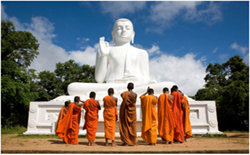 |
Arunachal Pradesh is gifted with traditional craftsmen skills that have been passed on from generations to generations. Local men are skilled in weaving, carpet making, wood carving, painting, pottery, ornament making, cane and bamboo work, smithy work, basketry and many others. The women are expert in making handicrafts and handlooms.
|
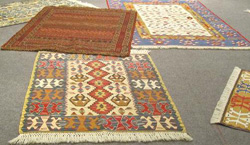 |
Arunachal Pradesh is situated in the farthermost north-eastern border of India. The influence of tribal communities and nearby Himalayan civilisations is quite evident in the local cuisine of this area. Rice and meat are the staple food of Arunachal. Lettuce is quite popular among locals and it is cooked using green chillies, coriander and ginger. Boiled rice cakes, Thukpa and momos are the traditional dishes devoured by people. The food is less on spices and is generally mild. Various forms of rice beers are prepared by local communities, one of them being Apang which is prepared by fermenting rice and millet. Due to the high amount of variedness among local communities, the food preparation methods differ slightly from district to district.
|
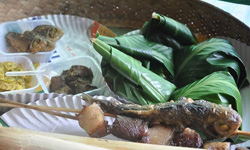 |
People of Arunachal celebrate various occasions and for various reasons, be it religious, socio-cultural or agricultural. The tribal people are simple living people and derive happiness out of small things in life. Festivals are a source of getting together and sharing moments of joy with each other. Some of the prominent festivals celebrated in Arunachal Pradesh are Losar, Solung, Boori-Boot, Mopin, Dree, Nyokum, Reh, Si-Donyi, etc.
|
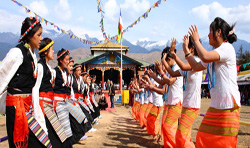 |
Dance and music are an essential part of the life of Arunachali tribes. They dance and sing on important occasions and during the time of festivities and weddings. Various dance forms are seen in different parts of Arunachal. From elaborate religious dance dramas of the Buddhists to the martial arts and colourful dance performances of the Noctes and Wanchos, dance forms of Arunachal come in various formats. They can broadly be divided into four categories- Festive Dances, Ritual Dances, Recreational Dances and Dance Dramas.
Some popular folk dances in Arunachal Pradesh are Aji Lamu, Chalo, Hiirii Khaniing, Popir, Ponung, Pasi Kongki, Rekham Pada, Roppi, Lion and Peacock dance. Most of the dance forms are accompanied by chorus songs. |
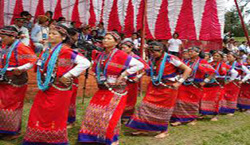 |
Arunachal Pradesh is perhaps one of the most linguistically diverse states in Asia. More than 50 dialects of the Tibeto-Burman language structure can be observed here. Nyishi, Apatani, Bokar, Galo, Tagin, Adi are common languages which fall under the Tani dialect. Mishmi language is popular in the eastern part of the state. Digaru, Idu and Miju fall under mishmi and have been recognised as endangered languages. In the western and the northern districts, Bodic language is commonly spoken which is sub-divided into Dakpa and Tshangla. Starkly different from the commercial tourist destinations of the country, Arunachal Pradesh is just the right place for travellers looking for rejuvenation and peace in the lap of Himalayas. Apart from its breathtaking natural beauty, what makes this land truly magical is its vibrant and distinct culture. In a highly westernised world today, Arunachal Pradesh is a proud state in India, still preserving its ancient culture and traditions. |
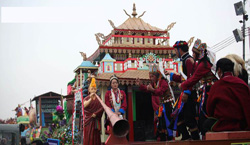 |
The state of Arunachal Pradesh is an exotic collection of socio-cultural life that blends many types of cultures, and traditions. Shawls, skirts, wraps, lungis are the fashion favorites here. With 26 distinct tribes and over 100 sub-tribes, Arunachal Pradesh is a treat for those interested in a glimpse of cultural diversity. Being essentially a tribal state, festivals and social events like weddings are an integral part of the life of the people here. While most tribes are ethnically similar, having derived from the same ancestors, their geographical separation has brought in the different customs in dressing styles. The tribes of Arunachal Pradesh are known for their weaving, with the Aptani tribe being the most advanced in its techniques. Using fibers from trees, goat and human hair, they create ceremonial coats, shawls, skirts, sashes, lungis (loin cloths) with various forms of embroidery. |
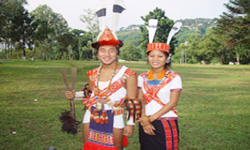 |

